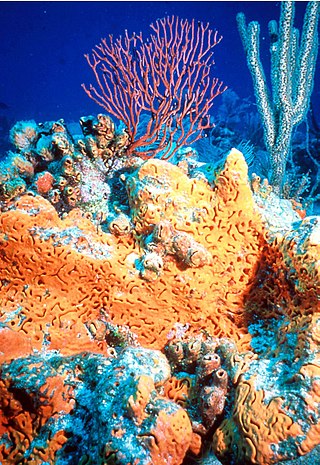
Thomas (Tom) Cavalier-Smith, FRS, FRSC, NERC Professorial Fellow, was a professor of evolutionary biology in the Department of Zoology, at the University of Oxford.

The metamonads are a large group of flagellate amitochondriate microscopic eukaryotes. Their composition is not entirely settled, but they include the retortamonads, diplomonads, and possibly the parabasalids and oxymonads as well. These four groups are all anaerobic, occurring mostly as symbiotes or parasites of animals, as is the case with Giardia lamblia which causes diarrhea in mammals.

Amorphea is a taxonomic supergroup that includes the basal Amoebozoa and Obazoa. That latter contains the Opisthokonta, which includes the Fungi, Animals and the Choanomonada, or Choanoflagellates. The taxonomic affinities of the members of this clade were originally described and proposed by Thomas Cavalier-Smith in 2002.

A bikont is any of the eukaryotic organisms classified in the group Bikonta. Many single-celled and multi-celled organisms are members of the group, and these, as well as the presumed ancestor, have two flagella.

Malawimonadidae is a family of unicellular eukaryotes of outsize importance in understanding eukaryote phylogeny.
Micronuclearia is a genus of free-living protozoa containing the single species Micronuclearia podoventralis. While originally thought to be a nucleariid, as reflected in the name, it is now inferred to be a member of the taxon Rigifilida, and to belong to the 'CRuMs' assemblage.

Loukozoa is a proposed taxon used in some classifications of eukaryotes, consisting of the Metamonada and Malawimonadea. Ancyromonads are closely related to this group, as sister of the entire group, or as sister of the Metamonada. Amorphea may have emerged in this grouping, specifically as sister of the Malawimonads.

Holozoa is a clade of organisms that includes animals and their closest single-celled relatives, but excludes fungi and all other organisms. Together they amount to more than 1.5 million species of purely heterotrophic organisms, including around 300 unicellular species. It consists of various subgroups, namely Metazoa and the protists Choanoflagellata, Filasterea, Pluriformea and Ichthyosporea. Along with fungi and some other groups, Holozoa is part of the Opisthokonta, a supergroup of eukaryotes. Choanofila was previously used as the name for a group similar in composition to Holozoa, but its usage is discouraged now because it excludes animals and is therefore paraphyletic.

Ancyromonadida or Planomonadida is a small group of biflagellated protists found in the soil and in aquatic habitats, where they feed on bacteria. Includes freshwater or marine organisms, benthic, dorsoventrally compressed and with two unequal flagellae, each emerging from a separate pocket. The apical anterior flagellum can be very thin or end in the cell membrane, while the posterior flagellum is long and is inserted ventrally or laterally. The cell membrane is supported by a thin single-layered theca and the mitochondrial crests are discoidal/flat.
Rigifilida is a clade of non-ciliate phagotrophic eukaryotes. It consists of two genera: Micronuclearia and Rigifila.
Rigifila is a genus of free-living single-celled eukaryotes, or protists, containing the sole species Rigifila ramosa. It is classified within the monotypic family Rigifilidae. Along with Micronucleariidae, it is a member of Rigifilida, an order of basal eukaryotes within the CRuMs clade. It differs from Micronuclearia by having two proteic layers surrounding their cytoplasm instead of a single one, and having more irregular mitochondrial cristae, among other morphological differences.

Podiates are a proposed clade containing the Amorphea and the organisms now assigned to the clade CRuMs. Ancyromonadida does not appear to have emerged in this grouping. Sarcomastigota is a proposed subkingdom that includes all the podiates that are not animals or fungi. Sulcozoa is a proposed phylum within Sarcomastigota that does not include the phyla Amoebozoa (clade) and Choanozoa (paraphyletic), i.e. it includes the proposed subphyla Apusozoa and Varisulca
The initial version of a classification system of life by British zoologist Thomas Cavalier-Smith appeared in 1978. This initial system continued to be modified in subsequent versions that were published until he died in 2021. As with classifications of others, such as Carl Linnaeus, Ernst Haeckel, Robert Whittaker, and Carl Woese, Cavalier-Smith's classification attempts to incorporate the latest developments in taxonomy., Cavalier-Smith used his classifications to convey his opinions about the evolutionary relationships among various organisms, principally microbial. His classifications complemented his ideas communicated in scientific publications, talks, and diagrams. Different iterations might have a wider or narrow scope, include different groupings, provide greater or lesser detail, and place groups in different arrangements as his thinking changed. His classifications has been a major influence in the modern taxonomy, particularly of protists.

Varisulca was a proposed basal Podiate taxon. It encompassed several lineages of heterotrophic protists, most notably the ancyromonads (planomonads), collodictyonids (diphylleids), rigifilids and mantamonadids. Recent evidence suggests that the latter three are closely related to each other, forming a clade called CRuMs, but that this is unlikely to be specifically related to ancyromonads

Aphelida is a phylum of Fungi that appears to be the sister to true fungi.

The Orthokaryotes are a proposed Eukaryote clade consisting of the Jakobea and the Neokaryotes. Together with its sister Discicristata it forms a basal Eukaryote clade. They are characterized by stacked Golgi, orthogonal centrioles, and two opposite posterior ciliary roots.

The neokaryotes are a proposed eukaryote clade consisting of the unikonts and the bikonts as sister of for instance the Jakobea. It arises because the Euglenozoa, Percolozoa, Tsukubea, and Jakobea are seen in this view as more basal eukaryotes. These four groups, are traditionally grouped together in the Discoba. However, the Discoba may well be paraphyletic as the neokaryotes may have emerged in them.
Andalucina is a suborder of unicellular organisms in the order of Jakobida. Many species in Andalucina inhabit anaerobic environments.
Eolouka is a paraphyletic phylum of protists localized in the clade Discoba. It contains two lineages: Jakobea and Tsukubea, the last containing only one genus, Tsukubamonas.

Malawimonads are a small group of microorganisms with a basal position in the evolutionary tree of eukaryotes, containing only three recognized species. They're considered part of a possibly paraphyletic group known as "Excavata".


















